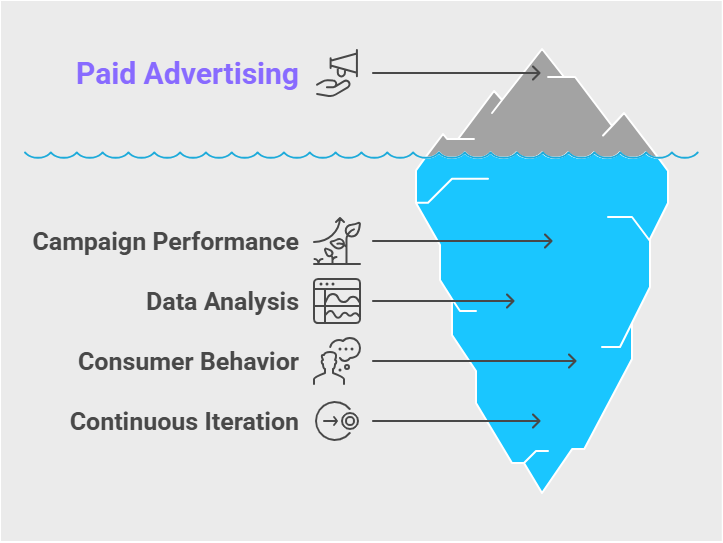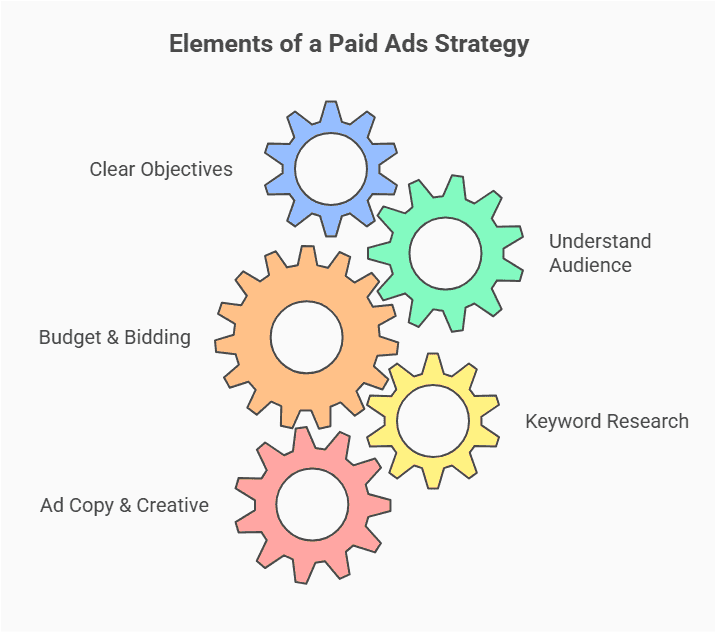Paid Advertising Strategy: elevating your digital marketing Strategy
What is Paid Advertising?
Definition & Basics
Paid advertising is a strategy where businesses pay to have their ads shown to potential customers online. These ads can appear in search engine results, on social media platforms, or on other websites. Common types of paid ads include paid search engine ads, display ads, social media ads, and video ads.
When we talk about paid advertising, there are a few key terms to understand:
CPC (Cost Per Click): The amount you pay each time someone clicks on your ad.
CPM (Cost Per Mille): The cost for every 1,000 impressions (or views) of your ad.
CPA (Cost Per Acquisition): The cost to acquire a customer through your ad.
CTR (Click-Through Rate): The percentage of people who click on your ad after seeing it.
LTV (Life-time Value): An estimate of the amount of revenue that a person gives your brand over their lifetime.
A digital marketing strategy like paid advertising matters today because it helps businesses reach a wider audience quickly. It can drive immediate traffic to your website and boost sales or leads. A solid paid ads strategy can work together with organic efforts like SEO. While SEO builds your website's long-term presence by making it easier to find on search engines, paid ads can give you a fast boost, especially when you need quick results.
The Role of Paid Ads in the Marketing Mix
Paid ads are an important part of a balanced digital marketing plan. They work best when integrated with organic strategies like SEO and content marketing. Using both together can increase your brand's visibility and improve engagement with your audience.
A diversified digital marketing strategy means you are not relying on just one method. Instead, you are using multiple channels to reach your customers. This makes your marketing efforts more effective and resilient, helping your business grow in a competitive online space.
Types of Paid Digital Advertising
Paid advertising comes in many forms, each offering unique ways to reach your audience. Here’s a breakdown of the main types:
Search Engine Marketing (SEM):
SEM allows businesses to show ads on search engines like Google and Bing. For example, Google Ads and Bing Ads let companies appear on a search engine results page when someone searches for a related product or service. Also known as a PPC Ads campaign, this helps drive immediate traffic to your website.
Social Media Advertising:
This type of advertising uses platforms such as Facebook (Facebook Ads), Instagram, LinkedIn, and Twitter. Social media ads reach users where they spend a lot of time online. They can help increase brand awareness and connect with specific groups of people.
Display & Banner Ads:
Display and banner ads are visual ads that appear on websites and apps. They often include images or graphics designed to catch the eye of visitors. These ads usually link to your website or a special landing page, inviting users to learn more about your product or service.
Video Advertising:
Video ads are shown on platforms like YouTube and other video sites. They can range from short commercials to longer stories that promote a brand. With more people watching videos online, video advertising is a powerful way to engage audiences.
Remarketing/Retargeting:
This digital ads strategy targets people who have already visited your website. By showing them ads again, you remind them of what you offer and encourage them to return. Remarketing is effective because it focuses on an audience that has already shown interest.
Using a mix of these paid advertising types can help build a strong online presence and reach customers.
How to Create Your Paid Ads Strategy
Creating a successful paid ads strategy starts with clear planning and understanding your audience. Here’s a simple guide to help you build your plan:
Setting Clear Objectives
Begin by defining what you want to achieve with your ads. Your goal might be to build brand awareness, generate leads, or boost sales. Make sure these goals match your overall business and marketing plans. This alignment ensures every ad you run works toward your bigger picture.
Understanding Your Target Audience
Know who you are trying to reach. Create buyer personas by outlining details about your ideal customers, such as their age, interests, and needs. You can learn more about your audience through surveys, checking social media insights, and studying what your competitors are doing. This research helps you design ads that speak directly to your audience.
Budgeting & Bidding Strategies
Decide how much you are willing to spend on your ads. Your budget will shape how often and where your ads appear. Explore different bidding strategies.
For example, you might choose to pay each time someone clicks your ad or every time it is shown to a thousand people. Choose the option that best meets your campaign goals.
Keyword & Audience Research
For search ads, keyword research is key. Find the words and phrases your audience uses when searching for products or services like yours.
Use tools to help select the best keywords. For social ads, focus on audience targeting methods available on the platform. This ensures your ads reach the right people.
Crafting Compelling Ad Copy & Creative
Write clear and engaging headlines and descriptions that capture attention quickly. Use visuals like images or short videos to make your ads even more appealing. Great ad copy and creative work together to draw users in and encourage them to click.
Platform-Specific Strategies
When planning your paid advertising, it's important to tailor your approach to each platform. Here are some key strategies for different types of advertising platforms:
Google Ads & Bing Ads
Search engine ads like Google and Bing are built around a clear structure of campaigns and ad groups. Organize your campaigns by themes and group related keywords together. This makes it easier to manage and optimize your ads.
Choose keywords that match what your potential customers are searching for. Then, craft ad copy that speaks directly to those keywords. Clear, direct language and a strong call to action can improve your ad's performance. Google Ads management also helps with your SEO strategy.
Meta Ads (Facebook Ads & Instagram Ads), LinkedIn Ads, X
Different social media platforms have their own unique styles. For instance, Facebook and Instagram often focus on engaging visuals and stories, while LinkedIn is more professional, and X is quick and concise.
Study each platform to understand what your audience likes on that channel. Use audience insights and engagement metrics to see what works best. This data helps you refine your ads and improve results over time.
Google Ads & YouTube Ads
Visual ads need strong images and clear messages to capture attention. For display ads, make sure your design is simple and your message is clear. For video ads, focus on creating content that tells a story and holds attention within the first few seconds. Optimizing your videos for engagement means keeping them short, clear, and focused on one message.
Tik Tok Ads, YouTube Shorts, Pinterest
Newer channels like TikTok and Pinterest Ads offer fresh ways to reach audiences. These platforms often have creative and interactive ad formats. Experiment with different styles and measure performance carefully. Use the insights you gain to adjust your strategies and stay ahead of the trends.
Paid Ads Tools and Resources
In paid advertising, having the right tools and resources can make a big difference in your campaign's success. Here are some of the most useful options:
Recommended Software and Platforms
For running ads, platforms like Google Ads, Bing Ads, Facebook Ads Manager, and LinkedIn Campaign Manager are essential. These tools help you create, manage, and track your ad campaigns. When it comes to analyzing performance, tools such as Google Analytics give you a clear picture of visitor behavior. Additional tools like SEMrush and Moz offer insights into your ad performance and your competition, while each ad platform also has its own set of analytics.
Free and Paid Educational Resources
Staying updated on trends and best practices is crucial. You can learn from online tutorials, webinars, and courses like Google Skillshop and Facebook Blueprint. These resources provide step-by-step lessons on how to use each platform effectively. Reading blogs, eBooks, and industry reports is another great way to keep your knowledge current.
Templates and Checklists
Using downloadable campaign planning templates can simplify the setup process. There are also checklists available for A/B testing, developing strong ad creatives, and tracking performance. These resources help ensure you cover all important steps and make data-driven decisions.
Community and Networking
Connecting with others in digital marketing can boost your skills and career. Join online forums, social media groups, and local meetups to share ideas and ask questions. Look for mentorship and internship opportunities to gain real-world experience. These connections can help you learn from seasoned professionals and stay on top of industry changes.
Using these tools and resources, you can build, track, and improve your paid advertising campaigns with confidence.
Measurement, Analysis, and Optimization
Measuring, analyzing, and optimizing your paid advertising is key to running successful campaigns. Here’s a simple guide:
Key Performance Indicators (KPIs)
Start by tracking essential metrics. Conversion rate tells you how many people take action after clicking your ad. ROI (Return on Investment) shows if you’re making more money than you spend.
Quality Score is a measure of your ad’s relevance and quality. To keep track of these numbers, use tools like Google Analytics and the insights built into ad platforms. These tools help you see how your ads are performing in real time.
A/B Testing and Experimentation
Testing is very important. Try different versions of your ad copy, visuals, and landing pages to see which one works best. This is called A/B testing.
For example, run two ads with different headlines to find out which attracts more clicks. Best practices include testing one change at a time so you can clearly see its impact. This helps you make informed decisions.
Optimization Techniques
Based on your tests, adjust your bids to get the most value from your ad spend. Refine your target audience by using data from your tests, and update your ad creative regularly. Ongoing analysis is vital. It lets you catch trends early and improve your ads continuously.
Reporting and Iteration
Finally, compile your results and create reports on how your campaigns are doing. Look at the data to see what worked and what didn’t. Use these insights to make small changes and try new ideas. This cycle of testing, measuring, and adjusting helps you refine your strategy and achieve better results over time.
Advanced Strategies and Future Trends
Advanced strategies and future trends in paid advertising are changing how we reach customers. Here’s an easy-to-understand guide:
Automation and AI in Paid Advertising
New tools let you use automated bidding, which means the system adjusts your bids to get the best results at the lowest cost. Dynamic ad creation uses computer programs to design ads that fit the viewer’s interests. AI-powered analytics helps you understand data quickly and make smarter choices. Many platforms now offer machine learning tools to optimize ads, making your campaigns more efficient without extra work.
Integrating Paid Ads with Overall Digital Marketing
Paid ads work best when they blend well with your other marketing efforts, like SEO and social media. A cohesive strategy means your paid and organic efforts support each other. Cross-channel strategies help you reach the same customer on different platforms.
For example, a person might see your ad on Facebook and then find your website through a search engine. Retargeting across platforms reminds potential customers about your product, increasing the chance they will return and make a purchase.
Future Trends in Paid Advertising
Privacy changes are affecting how ads target users. With more rules on data, companies must adjust how they reach audiences. Programmatic advertising is growing. This approach uses computers to buy ads in real time, ensuring your ad reaches the right person at the right moment. Real-time bidding, a part of programmatic advertising, lets you compete for ad space in an instant.
As technology grows, we can expect even smarter ad tools and better ways to measure success. These trends point to a future where ad tech is more responsive, efficient, and respectful of privacy.




